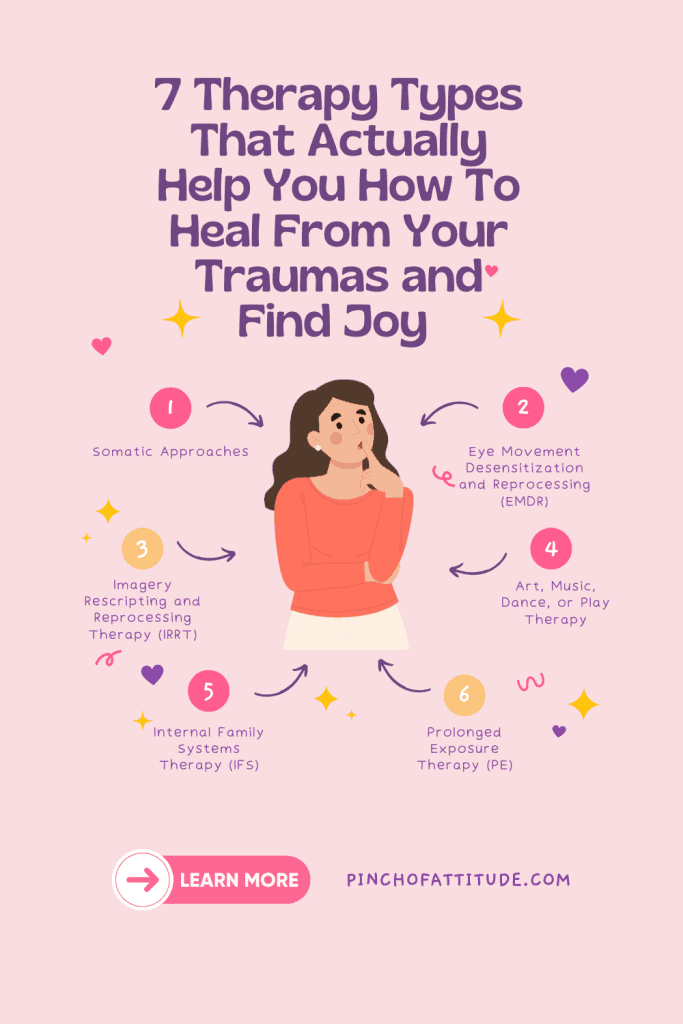I used to think therapy was just venting to a stranger once a week.
But after surviving years of subtle digs, emotional whiplash, and twisted manipulation from my narcissistic family, I realized I didn’t need to talk, I needed to heal.
I needed someone to help me unravel the trauma bond, rebuild my self-worth, and finally feel like I wasn’t crazy for how deeply it all hurt.
But not every therapist gets it.
And not every method works when you’re trying to recover from the mind games narcissists play.
If you’re still feeling stuck, lost, or triggered even after cutting ties or going low contact, you’re not alone.
These 7 therapy approaches changed everything for me and one of them might be the turning point you’ve been searching for.
Let’s break them down, one by one.
- There are various therapeutic approaches beyond traditional talk therapy that effectively address both the mental and physical aspects of trauma.
- Techniques like EMDR, somatic therapy, and inner child work offer unique ways to process and heal from traumatic experiences.
- Finding the right therapy for trauma involves exploring different options to discover what resonates best with your individual healing needs.
Table of Contents
1. Somatic Approaches

Somatic approaches like somatic psychotherapy and body psychotherapy are all about the connection between your mind and body.
Instead of just talking about your trauma, these therapies focus on how your body holds onto it.
Why It Works?
The goal here is to increase your body awareness and release the effects of trauma from your body.
Think of it like this: your body remembers what your mind tries to forget.
Through various body-focused techniques, you can let go of tension and trauma stored in your muscles and tissues.
Techniques Used

Techniques might include breathwork, movement, touch, and mindfulness exercises.
Therapists help you become aware of physical sensations and encourage you to explore and release these sensations.
For instance, breathwork can help calm the nervous system, while gentle touch can release tension stored in the muscles.
Movement exercises might involve stretching or yoga-like activities that help you connect with your body.
How It Helps?
By tuning into your body’s sensations, you can begin to understand and release the physical manifestations of your trauma.
It’s a holistic way to heal that addresses both your mental and physical well-being.
Many people find that somatic approaches help them feel more grounded and present in their daily lives.
It’s about creating a dialogue between your mind and body, fostering a sense of inner harmony and peace.
2. Eye Movement Desensitization and Reprocessing (EMDR)
EMDR stands for Eye Movement Desensitization and Reprocessing.
It’s a mouthful, but don’t let that scare you off!
This therapy involves thinking about your traumatic event while engaging in bilateral stimulation, like eye movements or tapping.
Why It Works?
The idea is that bilateral stimulation helps your brain process and reframe traumatic memories.
It’s like decluttering your mind and putting those painful memories in their proper place.
By engaging both hemispheres of the brain, EMDR helps integrate and make sense of traumatic experiences.
The Process
During an EMDR session, you’ll focus on a specific traumatic memory while the therapist guides you through a series of eye movements or other forms of bilateral stimulation.
This process is repeated until the memory becomes less distressing.
Sessions typically involve recalling the traumatic event, identifying negative beliefs, and replacing them with more adaptive thoughts.
How It Helps?
The goal of EMDR is to reprocess the trauma so it becomes less distressing.
Over time, those traumatic memories lose their emotional charge, and you can move forward with a lighter mental load.
Many people report significant relief after just a few sessions.
EMDR can be particularly effective for those who feel stuck or unable to move past their traumatic experiences.
3. Imagery Rescripting and Reprocessing Therapy (IRRT)

Imagery Rescripting and Reprocessing Therapy (IRRT) is a specialized form of trauma therapy designed to help people process and heal from distressing or traumatic memories, particularly those related to abuse, neglect, or PTSD.
Why It Works?
By increasing your awareness of how your childhood experiences contribute to your current struggles, you can start to heal those old wounds.
Understanding the impact of these early experiences can provide valuable insights into your current behavior and emotional patterns.
Techniques Used
Inner child work often involves visualization exercises, journaling, and dialogue with your inner child.
Therapists guide you in acknowledging and nurturing these younger parts of yourself.
You might be encouraged to visualize a younger version of yourself and have conversations to offer comfort and support.
How It Helps?
The aim is to reconnect with your inner child and reparent yourself.
This means giving yourself the love, support, and validation you might not have received growing up.
It’s a powerful way to heal and integrate all parts of yourself.
You’ll find that addressing these early wounds can lead to profound changes in your present life.
This process can help you develop a more compassionate relationship with yourself, fostering self-acceptance and healing.
4. Art, Music, Dance, or Play Therapy

Art, music, dance, and play therapy involve using creative and expressive activities to process and release trauma.
You don’t have to be a talented artist, musician, or dancer to benefit from these therapies.
Why It Works?
These therapies allow you to express emotions and experiences that might be too difficult to put into words.
Movement and self-expression help you release stored trauma and communicate your feelings in a non-verbal way.
Engaging in creative activities can bypass the limitations of verbal expression, tapping into deeper emotional and psychological processes.
Techniques Used
You might engage in activities like painting, drawing, playing instruments, dancing, or engaging in imaginative play.
Therapists provide a safe space and guidance to help you explore and express yourself.
In art therapy, for example, you might use colors and shapes to represent your feelings.
In music therapy, playing or listening to music can evoke emotions and memories.
How It Helps
Play therapy is often used with children, but adults can benefit too.
Engaging in creative activities can be a fun and freeing way to heal from trauma, helping you connect with your emotions and release pent-up energy.
Many people find these therapies to be a refreshing and enjoyable way to address deep-seated issues.
They offer a unique and often more accessible avenue for healing, particularly for those who struggle with traditional talk therapy.
5. Internal Family Systems Therapy (IFS)

Internal Family Systems (IFS) therapy is based on the idea that you have different psychological “parts” that serve various functions. Trauma can cause some of these parts to get stuck in unhelpful roles.
Why It Works?
IFS aims to reconnect you with these parts and increase your awareness of them.
By understanding and integrating these parts, you can resolve internal conflicts and let go of dysfunctional patterns.
This therapy helps you see yourself as a whole system, where each part has a role and purpose.
The Process
In IFS, you’ll work with your therapist to identify and communicate with different parts of yourself. These parts might include your “inner critic,” “protector,” or “wounded child.”
The goal is to understand their roles and help them heal.
You’ll learn to acknowledge and validate these parts, understanding their perspectives and intentions.
How It Helps?
The goal is to create harmony within your internal system, allowing you to heal from trauma by addressing the underlying issues that cause distress.
Many people find that IFS helps them feel more integrated and at peace with themselves.
This process fosters self-compassion and helps you develop a more balanced and healthy relationship with your inner world.
6. Prolonged Exposure Therapy (PE)

Prolonged exposure (PE) therapy involves gradually exposing you to your triggers in a controlled and safe environment. The key here is “gradual” and “guided by a therapist.”
Why It Works?
The idea is to reduce the power of traumatic memories and triggers by facing them head-on, but in a way that’s manageable and supported.
Exposure helps desensitize you to the trauma, reducing its emotional impact over time.
The Process
You’ll start by creating a hierarchy of triggers, from least to most distressing.
With your therapist’s guidance, you’ll gradually expose yourself to these triggers while using coping strategies to manage your anxiety.
This might involve imagining the traumatic event, visiting places that trigger memories, or discussing specific details of the trauma.
How It Helps?
Working through your triggers with the guidance of a therapist helps you build resilience and reduce the impact of trauma. It’s important to do this gradually to avoid retraumatization.
Over time, you’ll find that your triggers become less powerful and less frequent.
Many people experience significant relief and an increased sense of control over their trauma responses.
7. Cognitive Processing Therapy (CPT)

Cognitive Processing Therapy (CPT) focuses on restructuring unhelpful beliefs about yourself and the traumatic event.
It’s about analyzing and questioning your thoughts and modifying your behavior in response to identified patterns.
Why It Works?
By challenging and changing your negative thought patterns, you can reduce the emotional impact of trauma and develop healthier ways of thinking.
This therapy helps you understand the connections between your thoughts, feelings, and behaviors.
The Process
In CPT, you’ll work with your therapist to identify and challenge “stuck points”, unhelpful beliefs and thoughts related to the trauma.
You’ll also learn to replace these with more balanced and constructive thoughts.
This might involve writing exercises, cognitive restructuring, and discussing the trauma in detail.
How It Helps
The goal of CPT is to help you make sense of the trauma and its effects on your life, leading to a more balanced and less distressing view of yourself and the world.
Many people find that CPT provides them with the tools to manage their thoughts and emotions more effectively.
This process can lead to long-term improvements in mental health and overall well-being.
Therapy Costs and Where to Get Started
Alright, here’s the deal. You’ve got options, tons of them! On the links provided below, you can find therapists within your area who specialize in these methods
Click on them to get in touch with professionals who know their stuff and start your healing journey.
We’ve also put together a table that breaks down the costs so you can compare and choose the best option for your wallet and your well-being.
| Therapy Method | Cost Per Session | Sign-Up Links |
| Somatic Approaches | $60 – $200 | Find a Somatic Approach Therapist |
| EMDR | $75 – $250 | Find an EMDR Therapist |
| Inner Child Work | $150 – $200 | Find an Inner Child Work Therapist |
| Art, Music, Dance, or Play Therapy | $100 – $150 | Find an Art Therapist |
| Internal Family Systems Therapy (IFS) | $50 – $250 | Find an IFS Therapist |
| Prolonged Exposure Therapy (PE) | $100 – $250 | Find a PE Therapist |
| Cognitive Processing Therapy (CPT) | $125 – $225 | Find a CPT Therapist |
Related Posts:
- 6 Months Therapy: How Did It Help Me Heal From My Family Abuse?
- 15 Surprising Truths I Discovered in Therapy (And Why They Matter)
- 7 Stages of Narcissistic Abuse Recovery: Are You There Yet?
- 5 Types of People You Need While Healing From Narcissistic Abuse
- 30 Days Self-Love Challenge to Recover and Heal From Narcissistic Abuse
Frequently Asked Questions
What is EMDR therapy?
EMDR therapy involves bilateral stimulation, such as eye movements, to help process and reframe traumatic memories.
How does somatic therapy help with trauma?
Somatic therapy focuses on the mind-body connection, using techniques like breathwork and movement to release trauma stored in the body.
Can inner child work help with childhood trauma?
Yes, inner child work helps heal childhood trauma by reconnecting and nurturing the younger parts of yourself.
What is the goal of cognitive processing therapy (CPT)?
The goal of CPT is to restructure unhelpful beliefs and thoughts about the traumatic event, leading to healthier ways of thinking.
Are creative therapies like art or music therapy effective for trauma?
Yes, creative therapies provide a non-verbal way to express and process trauma, making them effective for many individuals.





Kolyanne,
This guide is simply FANTASTIC! I understand so much more now.
Thank you sincerely.
Lucia Sweeney ☘️
Thanks Lucia, I thought so because I was having a hard time back then when I needed help with that. Glad you found it helpful.